All posts by Nick Friend
The Expensive Lessons I’ve Learned About Customer Success
I have wasted millions of dollars failing in the area of Customer Success. It has costed me not only money, but an incredible amount of wasted time and headache.
So I am going to rant about it. Partially because I hope that you will take something away from it, partially because it will be cathartic.
If you came here expecting a manifesto or whitepaper on Customer Success, you’ll have to get that elsewhere. What you will get here is my unvarnished, real-life experience in the trenches as a CEO.
Because if you are anything like me, you’ve read hundreds of business books, listened to dozens of podcasts, read countless blog posts, and really honestly felt you knew a lot more than the average person about not only business, but also about Customer Success.
Well, after all the hustle and all the struggle — these are the expensive lessons that I learned and I am telling it the way that I see it.
Here we go.
1. It doesn’t matter how good your sales are, nor well you have validated your product up front.
In one of my companies, we validated the product so well upfront that our first year of revenues were $530,000.
Needless to say, we were good at up-front product validation.
Even more impressive about that number is we did that with two salespeople, no money spent on ads, and no marketing staff. When the market responds like that so quickly, it feels pretty damn good.
It certainly feels like you are on the right track and that you have created something that is truly solving customer problems.
But let’s get real. It never works that way in a startup.
So as you would expect, we eventually learned the hard way that killer sales doesn’t automatically result in customer success.
In fact, it can actually equal customer failure, high churn, negative reviews, and can leave you with a bigger pile of crap that you would ever want to deal with. Which is precisely what it did for us.
The lesson we learned is that we should have invested heavily into Customer Success from day one.
We should have hand-guided every single new customer to success, never leaving a single one behind. We should have built our company around that. We should have done things that don’t scale sooner.
We didn’t. We just sold like crazy, basked in the joy of the sales numbers coming in each month, and got high on our own supply.
It turned out to be a very expensive lesson. One I will never repeat and damn sure hope you don’t either.
2. It doesn’t matter how amazing your product is.
So our sales were rolling in, and we were getting amazing feedback about our product. Everything felt great.
But there was only one problem. The amazing feedback was only coming from 50% of the customers. Only, we didn’t realize that yet. We were busy.
Ya know, busy basking in our awesomeness.
But rumbling in the background was this other 50% of the customer base. Truthfully, there was very little feedback coming in from these customers. The little that came in was mostly negative. But there wasn’t much of it.
As such, it became very easy for everyone in the company to dismiss the little negative that there was. Oh that customer? Oh yeah, he’s crazy. Or lazy, or a bad-fit. Or just flat out stupid.
As it turns out, we were the stupid ones.
It doesn’t matter how amazing your product is. Our product was absolutely amazing, solved key customer problems, and garnered emotionally-charged, positive reviews from those who were able to use it and get value out of it. But none of that equated to Customer Success.
And so we still experienced various problems, including high churn.
So how did this happen?
Because there are people who will just not use your product, even after they buy it, if you don’t stay on top of them.
Yep, we had very small businesses (even sole proprietors) who spent $5,000-7,000 and never used the product. We thought that was impossible. Who on earth would spend that much of their hard earned money (especially when they complained about how broke they were already) and not make use of their investment?
It turns out, plenty will.
If you don’t get them to use the product soon after they buy it, many will turn sour on it. Most will churn.
And then there are people who want to get the value of your product, but can’t figure out how.
They are not as technically sophisticated as the other people. Or they are less patient. Or they have very high support needs or standards. Some of these people will ring the bell and ask for help — and you are lucky when they do. You actually have a chance to save those people.
But the vast majority will not. They will drift off into the sunset until the renewal eventually rolls around and they cancel.
Therefore, if you don’t have a good process in place to onboard and keep track of all of your customers and make sure they are on the right path towards success, you will end up with unsustainable churn.
Regardless of how amazing your product is.
3. Customer Success IS your product. Not whatever you thought it was before reading that line.
Nowadays, it doesn’t matter what product you sell. Whether you sell a physical product like coffee or if you sell SaaS software does not matter. If your customers are not successful using your product, they will not buy more, and you will fail.
Customers don’t buy the hole, they buy the drill.
You can be the best personal trainer in the world, but if you can’t get your customer to the gym – it is just a matter of time until that customer churns. And then you have to spend more time and money finding another customer.
You see, your customers are not buying your product as you see it — they are buying the success they expect to have as a result of using your product.
See below.
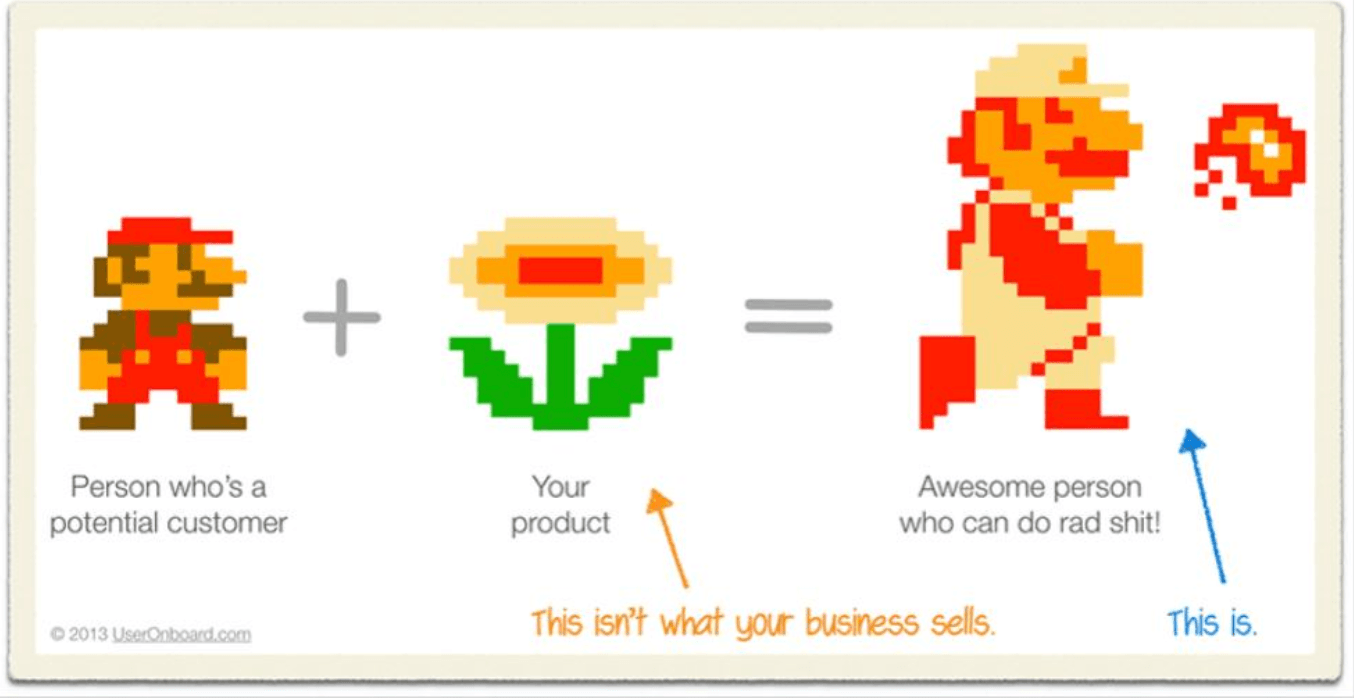
Your customer doesn’t want to buy the flower. They don’t even care about your flower. All they care about is becoming a fireball-tossing badass.
And so where we went wrong is we just continued to invest more and more into our product, thinking it would solve everything. Surely we would win if our product was the most amazing thing on the planet.
Wrong!
What we didn’t realize was that our product was already good enough.
And every feature we added only helped the people who were already successful with our product.
They weren’t the ones who needed the help.
The people we needed to help were those not using the product at all, because they got distracted early on, or who needed a little more help and guidance to achieve their desired outcome, or who needed some TLC due to a bad technical support experience or legitimate issue with the product.
And so we had to completely change our mindset to stop thinking of our “product” with an old-school, caveman mentality.
You know….the one where “me sell you product, the rest up to you”.
We finally internalized that the actual product we were selling was “achieving their desired outcome after interacting with our company”, because that’s what the customer was buying, in reality.
Well….with only 50% of our customers being successful after interacting with our company, we realized that our “product” wasn’t amazing. It actually sucked. “Interacting with our company” was failing half of our customers!
This was a profound epiphany internally. It was also very humbling.
So after internalizing that concept, we changed our mindset to view the entire customer experience as the “product”.
What did this mean?
It meant technical support and the way we responded to tickets was to be viewed as a feature in and of itself, no different than a feature of the product itself. It meant our knowledgebase of articles was also its own “feature”. Same with the advice and help of customer success team members and the entire process of how that could be deployed. All of these “features” contributed to the customer’s success, and they were all equally important.
And so in order for our product to truly be amazing, we realized that ALL of these things had to be amazing.
So we made them all amazing. Every point of customer interaction got the love and attention it needed. And this is precisely when everything changed for the better. All the metrics we tracked started shooting up in a positive direction and things like 5-star reviews and referrals started rolling in.
It costed us a shitload to learn this lesson. So please, realize that Customer Success is the only product you are selling. Adopt this mindset, and make it a part of your culture faster than we did.
4. Customer Success Should be the CEO’s Top Priority
Once we knew we needed to get better at Customer Success, we started hiring.
We hired “Customer Success” oriented people and gave them fancy titles like “Success Coach”. We threw money and people at the problem. We started tracking NPS in a sophisticated way. It felt good that we were finally being proactive.
We did manage to improve the obvious things. The quality of our support became great as evidenced by customer satisfaction (CSAT) scores. We added chat support and limited phone support, and both helped quite a bit (chat especially).
Nonetheless, it only really helped in one area, which was onboarding customers and making sure they got the support they needed to onboard. All of this managed to boost our “1-month after purchase” NPS score.
I mentioned earlier that we started tracking NPS in a sophisticated way, and this was by using cohorts. We began collecting NPS scores of customers 1-month, 3-months, 6-months, and 1 year after purchase. There is not an out-of-the-box tool that did this for us, I just knew it was the right way to measure NPS so we hacked our own solution.
So, as I was saying, the 1-month got dramatically better (our score was +50, which is really good), but everything after was shit. I believe our 3-month was at -40. I don’t even want to tell you our 6-month and 1-year. Do you know how bad a -40 score is? It’s really bad.
It’s something you need to take very seriously, or you won’t be around much longer.
Despite the concern about those numbers, the data was empowering. It truly exposed where the problem was.
It told me that we could onboard customers extremely well, but that still didn’t mean that they would be successful using our product. It didn’t mean that they would achieve their desired outcome. We had to change this.
We had to design a company that would maximize the success of the maximum number of customers.
And so it became very clear that there was going to be some serious work ahead. None of it was going to be easy.
It was at this point I learned that you cannot just throw money or people at a Customer Success problem. Customer Success is not just a department or some cute philosophy. It is everything. It is your product, it is the most important aspect of your company and any company for that matter. I am not overdoing this in the slightest.
I ultimately learned that Customer Success must become the CEO’s highest priority.
A CEO is essentially the quarterback of a company’s priorities. They decide what gets worked on, and what does not.
Here’s a question for every CEO out there: If a large portion of your customers are not successful, shouldn’t this both your biggest concern and your highest priority?
It should be. But if you are disconnected from this information, you will end up prioritizing other things that aren’t as important. Like new features for already happy customers.
Therefore, every CEO needs to be laser-focused on maximizing customer success. The realities within your own customer success situation should determine what your priorities are, not the other way around.
Let me get straight to the point.
You want high retention and low churn? Maximize customer success asap.
You want referrals and lower future CAC’s? Maximize customer success asap.
You want future up-sells and cross-sells? Maximize customer success asap.
I am willing to bet that everything you desire for your business, and every metric you are tracking, will go the direction you want it to if you focus on maximizing customer success asap.
Will that new feature — the one I know you are dying to implement — really make an impact on customer success where you really need it? Maybe you don’t need the dev team working on that. You only have so many resources, maybe this just isn’t a priority anymore.
Maybe what you really need is better documentation, better training, or more people on the phones providing one-on-one help. Maybe your dev team needs to be working on making the product easier to use, rather than adding new bells and whistles.
Whatever you need right now to maximize customer success — that is your next and most urgent priority.
Otherwise your company will be prioritizing things that seem cool but don’t help the largest percentage of your customers to become more successful. And this will surely cost you, as it did for me. Please, learn from my lesson.
5. Don’t Ever, Ever Underestimate How Challenging & Difficult Customer Success will Be.
You may have read everything so far and think I’m and idiot and I should have recognized all of these mistakes earlier.
I may be an idiot, but I’ve also built businesses from scratch to 8-figures. I’ve been nominated for awards in excellence in entrepreneurship several times. I graduated at the top of my class in both high school and college (University of Southern California). I started my first company when I was 19 and have multiple successes and failures under my belt. I’ve also seen a lot as an angel investor and in helping other entrepreneurs.
Ok, maybe I was an idiot when it came to Customer Success. That may be true as well, but you should know that I also started studying Customer Success as early as anyone. At one point, Customer Success pioneer Lincoln Murphy of Sixteen Ventures told me I was his most engaged customer in his mastermind group at the time (which I believe was around 2009-2010) and have been following him and other leaders in the field ever since.
Side Note: If you don’t know and already follow Lincoln Murphy then you need to be doing so. Subscribe to everything.
Now, I am not telling you any of this to brag. I am providing you context, hoping to make it dramatic enough so that you don’t brush this off.
The real point I am trying to make is that if it can happen to me, chances are it can happen to you.
The fact is, Customer Success is an abstract concept and will challenge you in ways you probably won’t anticipate.
It is highly intellectual, and it will require your best minds and best talent.
Maybe you are reading this and have had a simple customer success journey of your own. I have not had that luxury.
I can truly say it has been one the biggest challenges I have faced as a leader. But at the same time, it has been one of the most rewarding and valuable.
So in closing, I sincerely hope that this post recalibrates your perception of customer success and that you learn from the millions of dollars I have spent learning these lessons. Needless to say, it has been very expensive.
But we’ve made it through, and you can too, even if your numbers look bad right now.
I went on a journey from not taking customer success seriously, to sort of taking it seriously, to taking it very seriously, and then to ultimately having it become the centerpiece of everything I do.
Which is where it is today and is definitely where it will stay.
Maybe you already take Customer Success kinda seriously. I want you to take it more seriously. If you care at all about maximizing your numbers, I believe you will have no choice but to make it the centerpiece of what you do too. Make no mistake about it — Customer Success is the centerpiece of insanely good financial performance.
Finally, I can tell you today that what we are doing in terms of Customer Success is state-of-the-art. We are doing things that nobody else is talking about and it is having a massive impact on every critical metric. To say we are taking it seriously would be a massive understatement.
Stay tuned — I look forward to documenting more of this in a future post.
Getting from $0 to $10 Million is a Grind. It’s also our Specialty.

I bear the scars of multiple successful and failed startups, and have built businesses from scratch well into 8-figures. I can tell you right here, right now, that the journey from $0-10 million is by far the toughest part of the journey. There are so many facets to it. What you experience from $0-100k is completely different from what you will experience up to $1 million in revenue. What you experience from $1M to $2M, and then $2M to $4M will be completely different and will have unique challenges.
What I have found is that $0-10 million is where the most help is needed. It’s a grind. It’s hell. It’s everything in between. It is therefore what I am focusing on with our content. I am riffing on the things that you are, or will be going through on a daily basis. I am giving information hot off the daily press of what is happening right now to keep you ahead of the times.
If you like what you are hearing, and if you like what we are discussing then give us a follow on Insta, Facebook, Twitter. If you one day feel so inclined, tag a friend who is currently in the entrepreneur journey who might benefit from this content. Leave a comment on one of our posts and share your experiences, thoughts, challenges, troubles. I want to hear from you. I know what you are going through and the ride that you are on.
True Leadership Feels Like Dragging People Kicking & Screaming
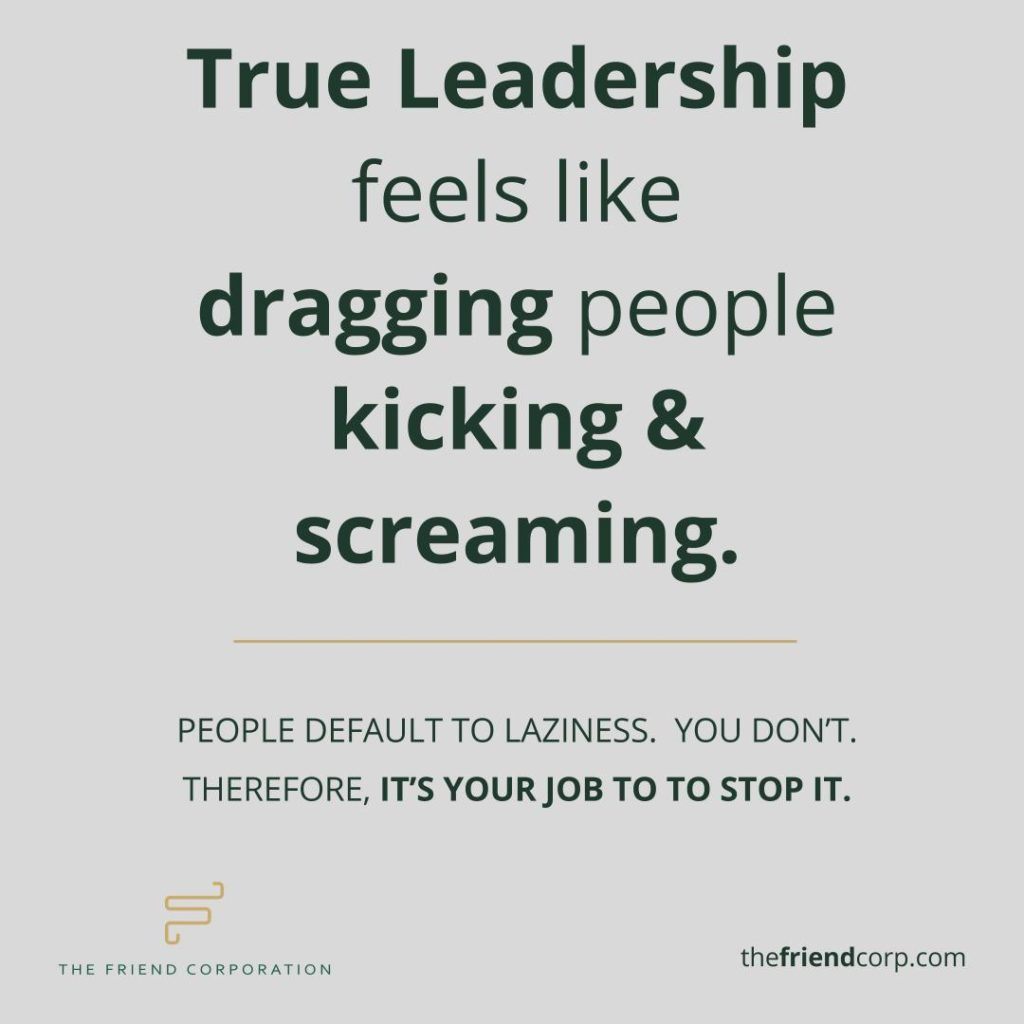
If you aren’t constantly dragging your employees or direct reports towards excellence, faster execution, and continuous improvement then you will notice that they will eventually default back to status quo, being average, and remaining in their comfort zone. It’s why there are very few true leaders in this world while the rest are just along for the ride, who buy things like lottery tickets, all because they truly want the easy path. Which is why as a leader, you have two choices. You either drag your people forward with high energy and push them into a constant state of continuous improvement, or watch them default back to their own, average, status quo. If you drag them forward, you will have a chance at achieving excellence in your company or department. But if you leave them to their own devices, you will achieve nothing more than their “average”.
But you aren’t doing this to be average, right? Exactly. So, as a leader you need to be very careful with words like “autonomy”. Like anything, “autonomy” given without this flavor of leadership can result in status quo performance.
Leaders are intrinsically motivated to work hard, pursue excellence, and completely reject the status quo. It’s who we are. But its equally as important to know that this is not who everyone else is. Therefore, when you are really leading it should feel like you are making people feel uncomfortable. They should feel like they are doing things and are being challenged in ways never experienced before. To you, it should feel like you are dragging them to a point of almost kicking and screaming.
If it doesn’t feel this way right now, then you aren’t setting the bar high enough. As such, you aren’t moving as fast as you could be and time is a wastin’. So go set it higher. Right now.
Fix Your Own Machine During this New Years’ Downtime
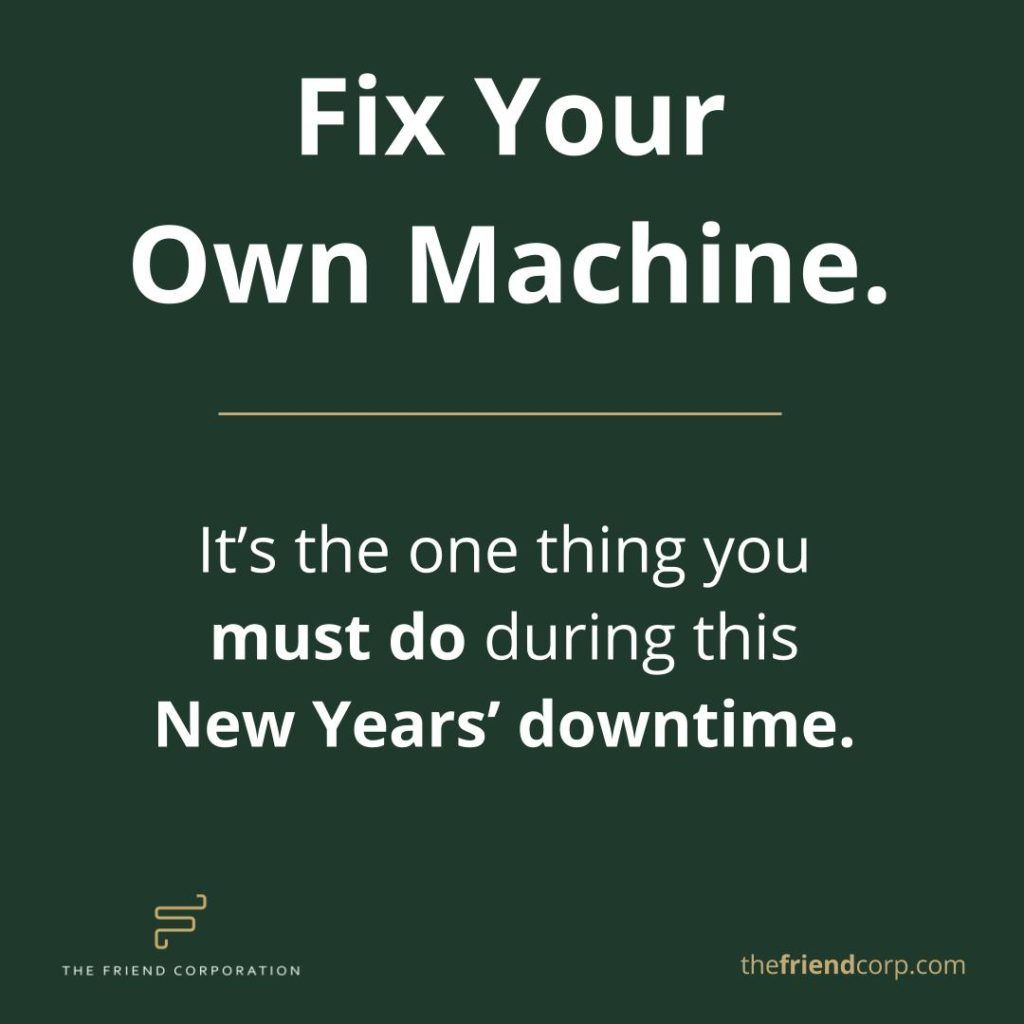
I have previously posted that a “Business is a machine that produces outcomes”. When you begin to treat a business like a machine, you start to realize that the reason problems continue to get created is because somewhere the machine is broken. Maybe you are missing a process, or a policy. But somewhere it is broken and you need to fix it.
In the same way — we, as individuals, are also machines that produce outcomes in our own lives and in our businesses. Those outcomes are either good or bad; but 100% of the time, these outcomes are your fault. If you don’t fix your own machine (i.e. you!), the way you think, operate, execute, and manage other individuals — then you are going to continue to have the same outcomes.
This is why it is imperative to reflect on your 2017 as this year comes to a close. You need to think about the goals you didn’t accomplish. The things that didn’t go the way you wanted them to. The crises that continue to pop up in your business. Write them on a list. Then, you need to map out the process or series of steps that created each of these outcomes.
You need think like an engineer who is fixing a robot – literally. The scary part about this process is, you will quickly realize how robotic you are, in how you mindlessly we all follow certain patterns, biases, assumptions, or ways of doing things every day when some might actually be the cause of future bad outcomes. But if you take the time right now to stop, reflect, identify the broken parts of your own machine then you will go into 2018 with the best version of your machine. That’s what I want you to do. As such, your 2018 will be set up on day 1 towards a completely different success trajectory.
Embrace that Your Assumptions will be Wrong
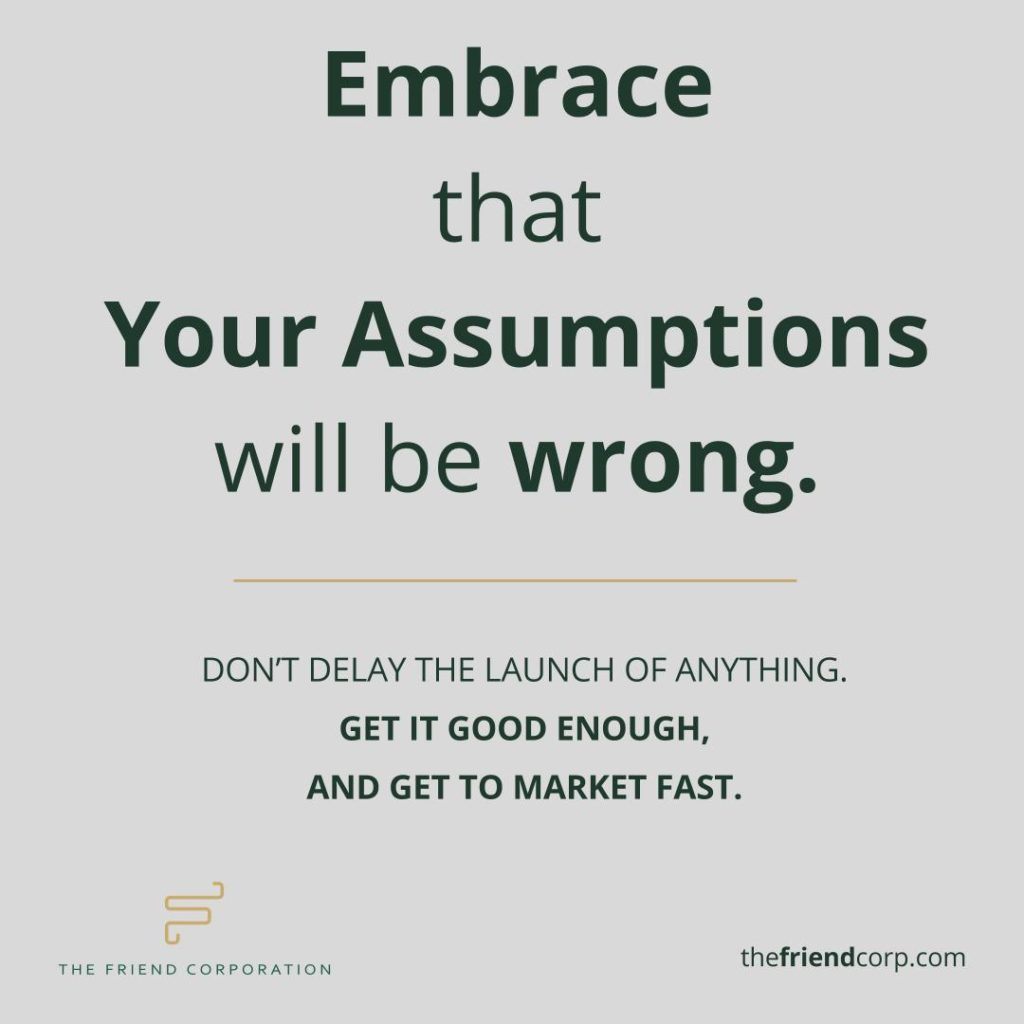
Once you embrace that your assumptions about your customer will almost always be wrong, you realize that launching faster is far more important than trying to get it perfect upfront. The marketplace is the ultimate truth. Only after you launch will you get real feedback from real customers. Which means that within days, you will learn that several — if not many — of your upfront assumptions were wrong.
Once you realize this, you can start to see that it is a complete waste to allow yourself, or your teams, to spend tons of extra time and resources trying to make something “perfect” and allowing “perfect” to delay your launch. It’s literally money and resources flushed down the toilet, because you don’t know what perfect is yet. BUT — what I am willing to bet, is that YOU DO KNOW what is “80% perfect” right now and you can get that to market quickly. So, your job as the CEO of your world is to define what is 80% perfect and then push everyone to get that product or feature to market (even as a small, controlled beta test) as quickly as possible.
Have you ever noticed or tracked how expensive the remaining 20% of any feature, project, or product is? I have. I have been a part of too many projects where a team will get 80% done in one day, yet it takes an extra 30 days just to complete that last 20% of perfection. I’m sure you have too. It’s those projects that just linger and never get done. It’s those projects that randomly pop in your head and you immediately think WTF why is that not done yet, and then you step in and realize everyone has been overcomplicating it. They are overcomplicating it because they are banking on their assumptions. They want to be right and are scared to be wrong.
So I encourage you to take stock right now of any product, feature, or project you are working on — especially those that seem to be dragging on. Find the 80/20 in it, and I’m willing to bet you can get it completed in 1-2 days. More importantly, teach everyone on your team to embrace that their assumptions will always be wrong, so will yours, and that this is just a fact of business. It’s nothing to get emotional about. Doing this will create a culture based on fast execution, getting to market quickly, and collecting customer feedback as the way to ultimately achieve perfection.
Take Advantage of Holiday Attention
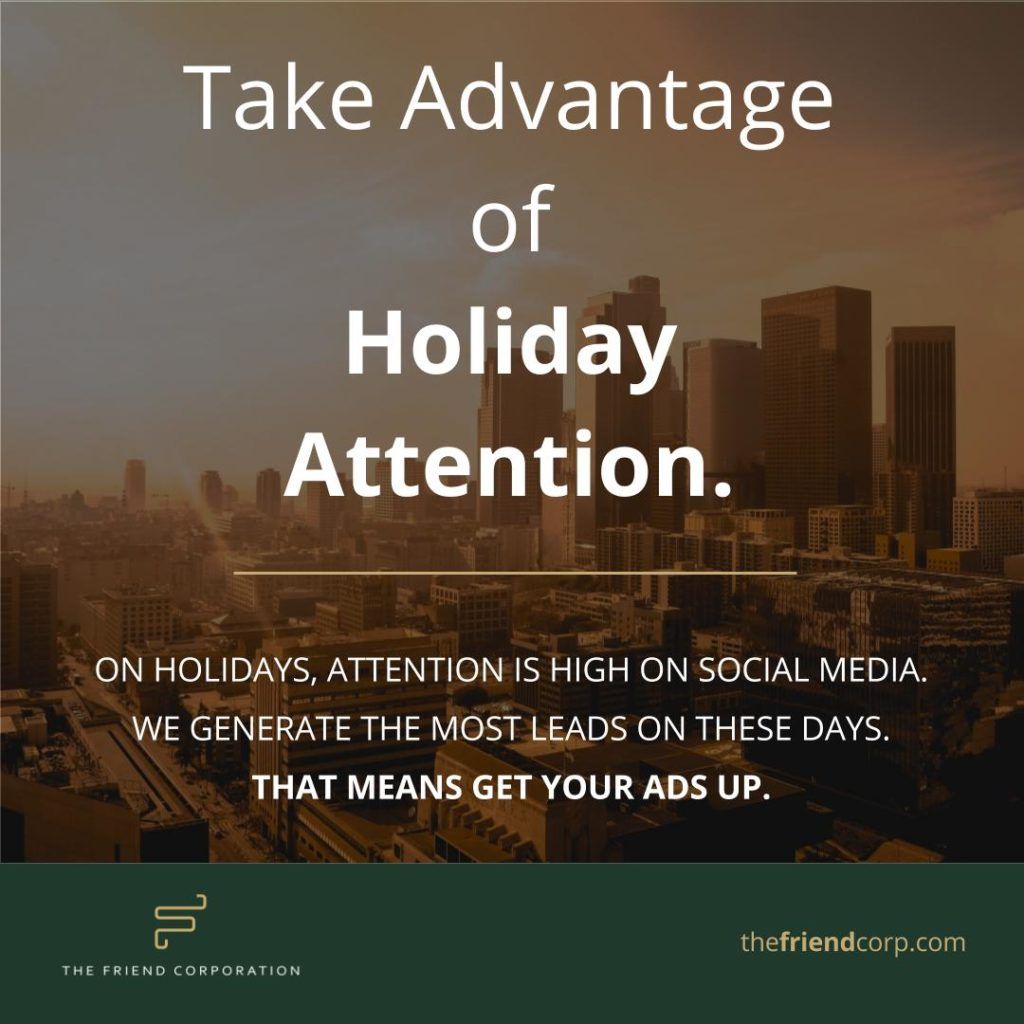
During the Holidays, people have extra time on their hands. They spend a lot of that time on their phones, and they also spend more time than normal thinking about their future. We have noticed that whenever we put ads up on Facebook or Instagram during Holidays we generate a much larger influx of leads when compared to ordinary times. We also notice that people engage more with our content, once they arrive at the website or blog, which means they move down the sales funnel faster. Good times!
You may not have any content ready right now, since Christmas is tomorrow. But you’ve got New Years right around the corner. Try to make it happen. You want to apply this concept to any Holiday where people have work off. Memorial Day, Labor Day, 4th of July — all of these work. If the Holiday is on a Monday, make sure the ads are up all weekend, not just the day of the Holiday.
Leverage Positive Customer Feedback to Hack Culture
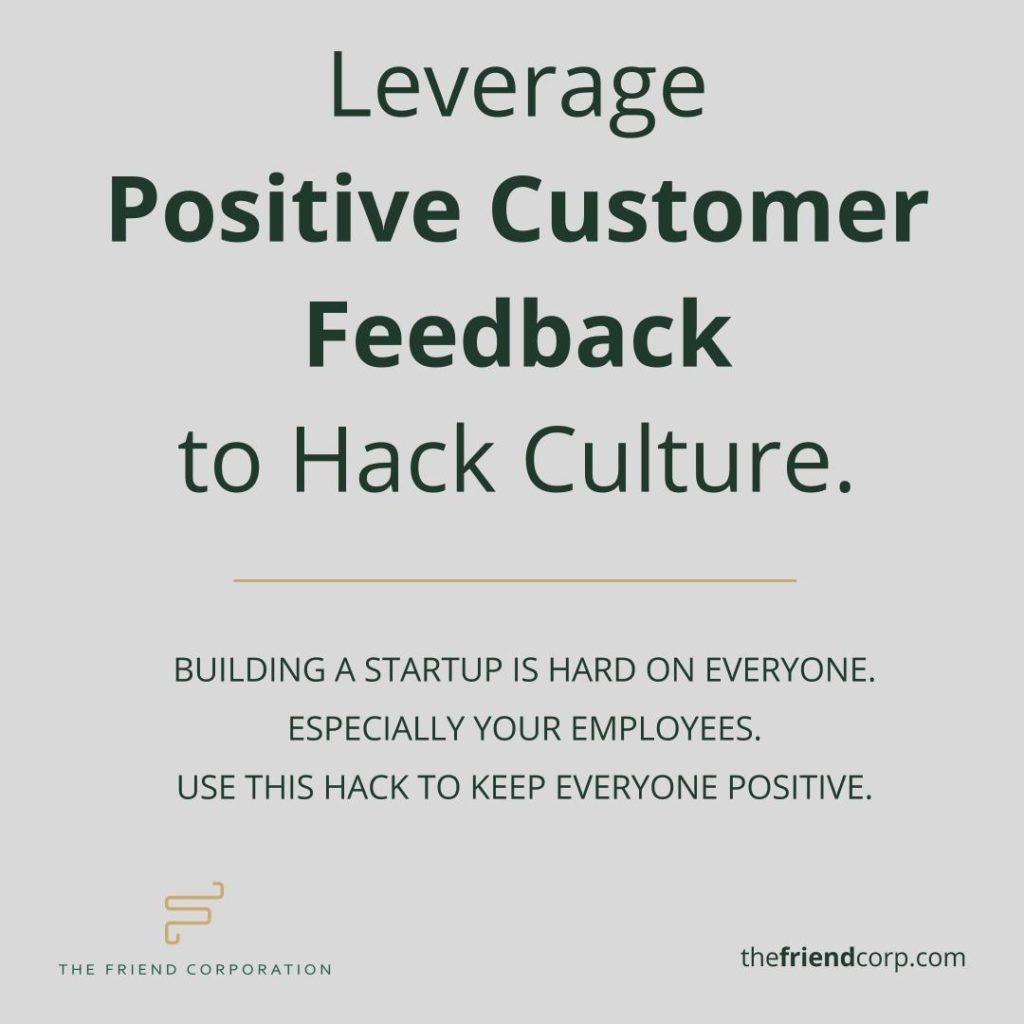
Early on in a startup, when times are really tough, when some inevitable negative reviews come in, it is really easy for your internal culture to starting leaning towards negativity. People start wondering whether the company will make it, whether they should continue working there, which all has a cascading affect on company performance. The worst part is when the startup is actually doing well, and is just experiencing the normal challenges of early growth. So how can you resolve this?
A hack we have found to be very effective is to implement a process of aggressively collecting and sharing positive customer feedback. First, we try to collect it everywhere — in support tickets, and by asking for reviews from our happiest customers, all of this on an ongoing basis. Then, each time one of them comes in, we post it into a dedicated Slack channel called “Positive Feedback” which everyone in the company sees. What you will notice is that employees start chiming in, celebrating each win, and congratulating any employees that were singled out by the customer.
All of this serves as both fuel and medicine for the startup. Fuel in that employees get fired up that the company has a purpose and is really solving customer problems. Medicine in that it almost completely squashes any underlying negativity within the culture. When fuel and medicine are flowing continuously it is extremely powerful.
So the key here is to create your own system to leverage all incoming positive customer feedback. If your company doesn’t use Slack, then print them out and have a quick 5-10 minute company-wide meeting about them every Friday. How you do it doesn’t matter, just make sure you do it.
Every startup needs both fuel and medicine anywhere it can get it. So do not let a single instance of positive customer feedback go to waste.
Early On, Do Things That Don’t Scale
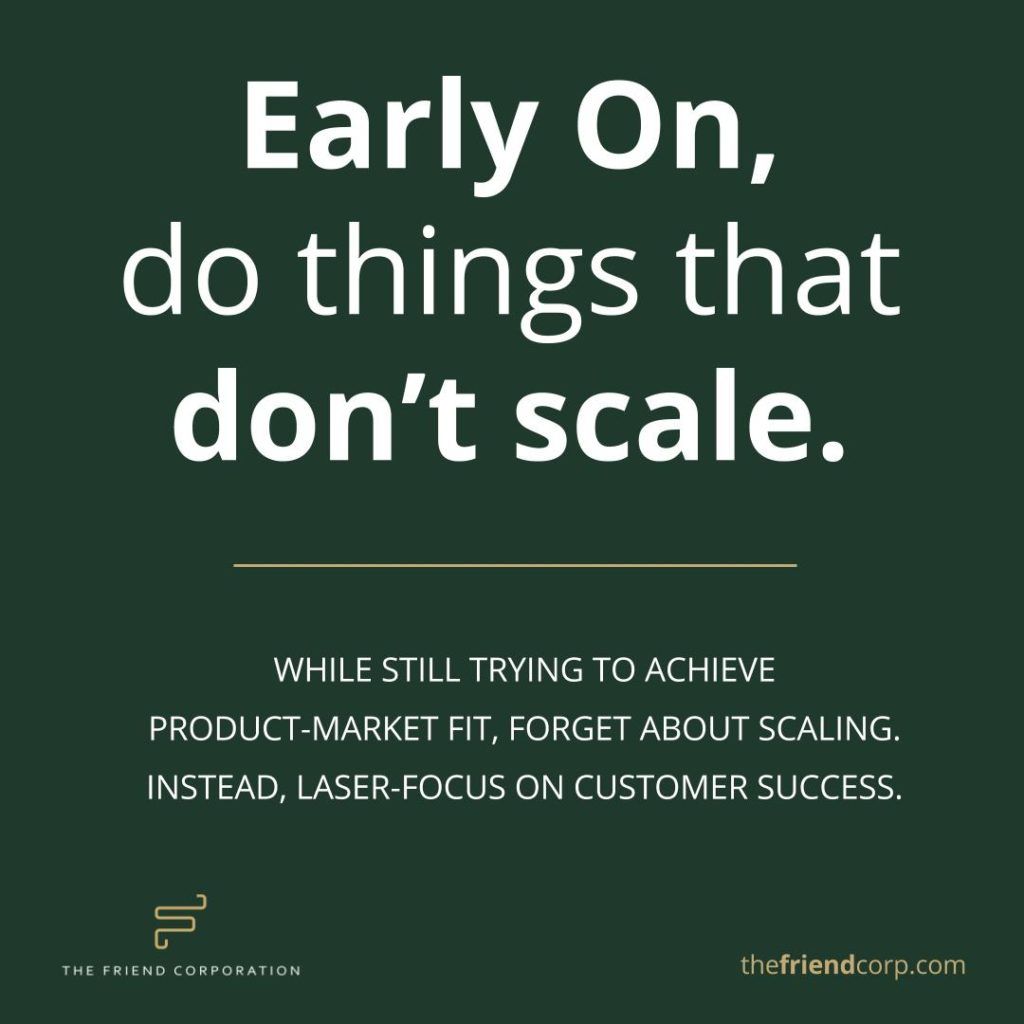
When you start out, or your revenues are below $2 million, “scaling” is not a priority – yet. Still, I hear this all time: “I can’t do x, because it won’t scale!”. While you are still trying to achieve product-market fit, the words “but that doesn’t scale” shouldn’t ever cross your mind. You just need to attack and solve problems, irrespective of scale.
Even if that means calling every one of your first 50 customers to make sure they are successful with your product. Even if that means doing a highly manual, labor-intensive process up front. Even if that means the CEO is handling 50% of the support tickets up front.
Your primary job is to find a way to make your product fit, and to make your customers successful, or frankly you won’t be around much longer. Yes, it will cost you more to do so — you may have to overstaff, you may have to spend hours on things that suck and that you didn’t plan on doing.
But the truth is that it will take multiple iterations before you figure out what actually works and makes your customers happy and successful. Which is why it is a complete waste of time to talk about what will or will not scale up front. You don’t even know what you really need to be doing yet! Once you actually go through the iterative process and figure this out — THEN you can figure out how to scale it.
Trust me, this may be hard to see now. You may be tempted NOT to do something because you “know” right now it won’t scale. Don’t fall for it. Solve problems first, scale after. Once you know exactly what you need to do, you WILL come up with creative solutions on how to scale it. You’ll look back and be relieved that you didn’t get in your own way.
Check out this post from Paul Graham of Y Combinator how billion dollar companies like AirBnB and Stripe did things that didn’t scale early on.
Facebook Messenger is the New Email
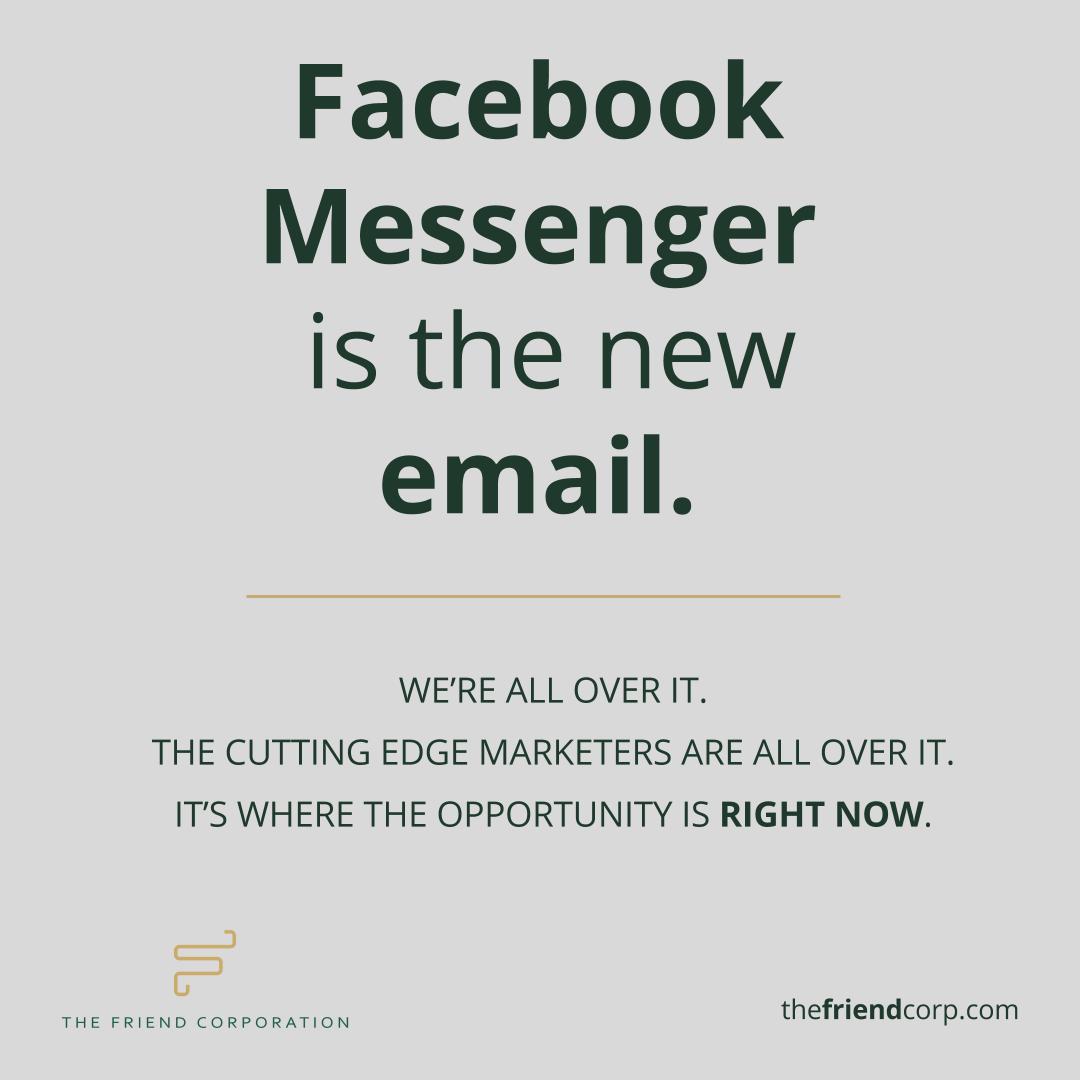
![]()
I am here to deliver you with value and nothing else — So let me say what I am about to tell you is on the cutting edge in marketing and is seriously ahead of the times. Ahead of the times = low cost clicks, better engagement, and better ROI on your marketing spend. Which means you can grow faster at a much lower cost. Do I have your attention?
Remember when email open rates used to be 80%? Maybe you haven’t been in the game as long as I have, but that’s how it used to be 15 years ago. It was a party back then. Just send out an email blast, everyone on your list saw it, and the results poured in. Today, you’re lucky to get a 25% open rate. The spam has ruined it. Email marketing still works and we do plenty of it, but the party has been long over.
Right now, if you get people to opt-in to your Facebook messenger, you can get 80%+ open rates on the broadcast messages you send. And rather than going into their email box, they are going right to their phone like a text message or they pop right in your browser while on Facebook (in the chat window). That in and of itself is unreal. What I can tell you right now that our teams are spending a bunch of money on it right now to figure out the game and take advantage of the current arbitrage. If you look at any of the cutting edge marketers and growth hackers, they’re doing it too. There is a lot of tradecraft to it. You’re probably not ready for it. But I want it on your radar. The results we are seeing on it so far are insane. There is a lot more to cover on this topic so stay tuned…
Customer Success IS Your Product
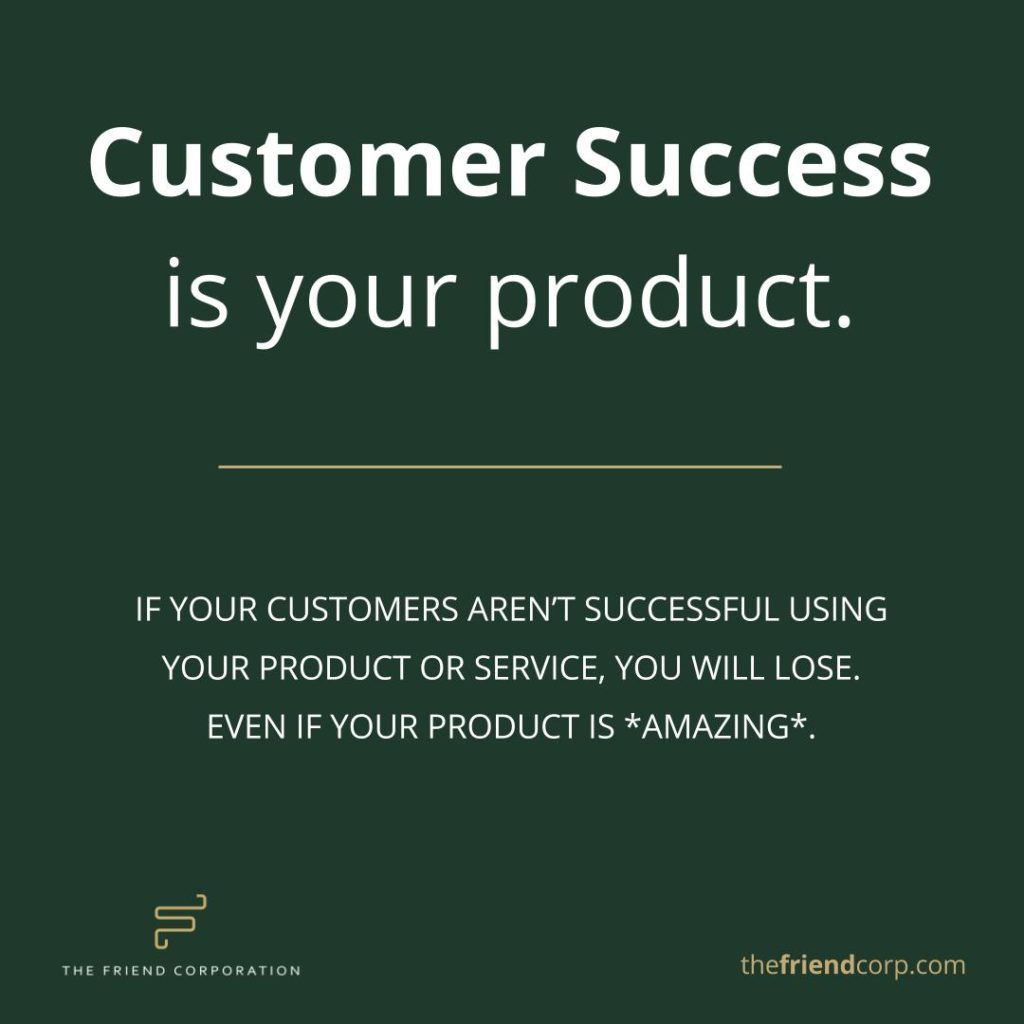
No matter what type of company you run, your job is to make your customers successful with your product or service. If you don’t, they will churn — no matter how amazing your product is. If I hire a personal trainer and he doesn’t manage to get me to the gym, I will churn — even if he is the best trainer in the world. If I am looking to buy real estate and my agent doesn’t lead me to good deals and successful outcomes, I will churn. Churn is a problem that kills your company’s ability to stack revenues from customers you already acquired, sold, and have built a relationship with.
This is not the 1990’s anymore. You are not selling a product or service that is left for the customer to figure out. Customers will end up churning simply by not using your product due to laziness or distraction, not following your guides, and many other reasons that don’t seem to be your fault. But THEY ARE YOUR FAULT. YOU have to guide them to success in using your product or service. You have to be proactive about it, even aggressive. The customer is never happier, more excited and motivated than the day they first buy. Your job is to maintain that while you guide them to their successful outcome.